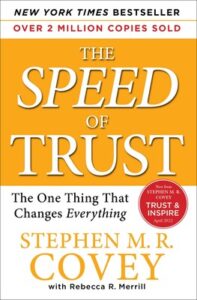Behavior #1: Talk Straight, page 136.
Summary: Behavior #1 – Talk Straight
- Be honest.
- Tell the truth.
- Let people know where you stand.
- Use simple language.
- Call things what they are.
- Demonstrate integrity.
- Don’t manipulate people or distort facts.
- Don’t spin the truth.
- Don’t leave false impressions.
Behavior #1: Talk Straight
- “Talk Straight” is honesty in action.
- It’s based on the principles of integrity, honesty, and straightforwardness.
- “Talk Straight” means two things: Tell the truth and leave the right impression.
- It’s possible to tell the truth and to leave the wrong impression.
- Leaving the right impression means communicating so clearly that you cannot be misunderstood.
- The opposite of Talk Straight is to lie or deceive. Such behavior creates a huge tax on interactions – either immediately or later when the deception is discovered.
- Most people do not flat-out lie – at least not blatantly. Instead, they engage in the counterfeit behaviors of Talk Straight:
- Beating around the bush
- Withholding information
- Double-Talk
- Flattery
- Positioning
- Posturing
- The granddaddy of counterfeit behaviors is “spinning” communication to manipulate the thoughts, feelings, or actions of others.
- Another dangerous counterfeit is “technically” speaking the truth but leaving a false impression. This is mincing words and legally splitting hairs.
The Impact on Speed and Cost
- According to a 2005 Mercer Management Consulting study, only 40% of employees trust that their bosses communicate honestly.
- Instead of talking straight, much organizational life is filled with spin. This creates what I call a “spin tax,” and is one of the main reasons why trust is low in many organizations.
- Sometimes entire cultures are held hostage by a downward cycle of spin and posturing. This diminishes trust and creates an additional “withholding tax” where people withhold information and keep things “close to the vest.”
- As a result, companies often have three meetings instead one:
- The Premeeting – to prepare and position.
- The Meeting Itself – The “Spin and Withholding” meeting.
- The Meeting After the Meeting – The smaller meeting where the real discussion happens and the real issues are aired.
- When a culture is caught up in a downward cycle of spinning and withholding, it requires great courage to Talk Straight.
- When people do have the courage to Talk Straight, amazing things happen. Communication is clear. Meetings are few, brief, and to the point. Trust increases. Speed goes up. Cost goes down.
When Talk Straight is Taken to Far
- Like all of the other behaviors, Talk Straight can be taken too far.
- While Straight Talk is vital to establishing trust, it needs to be tempered by skill, tact, consideration, and good judgment.
- The key to optimization is to make sure that each behavior is at its highest point of connection with the 4 Cores.
- When you blend courage (Integrity) with a mutually beneficial agenda (Intent), with the ability to address situations directly (Capabilities), and focus on building trust (Results), you have the discernment that enables you to Talk Straight in a way that significantly increases trust.
Improving Your Ability to Talk Straight
- Ask yourself: What keeps me from talking straight?
- Is it fear of the consequences?
- Fear of being wrong?
- Fear of hurting others’ feelings?
- Is it a desire for popularity?
- Become aware of your conversation:
- In the middle of an interaction, stop and ask yourself, Am I talking straight – or am I spinning?
- If you’re spinning, figure out why.
- Learn to get to your point quickly:
- Avoid giving long prologues or excessive context
- The personal discipline of talking straight helps create precision of language, an economy of words, and a lack of spin.
- Involve other people:
- Tell them, “I’m trying to improve my ability to Talk Straight in my communications with others. Would you be willing to help me by giving me feedback to let me know how I’m doing in my relationship with you?”



